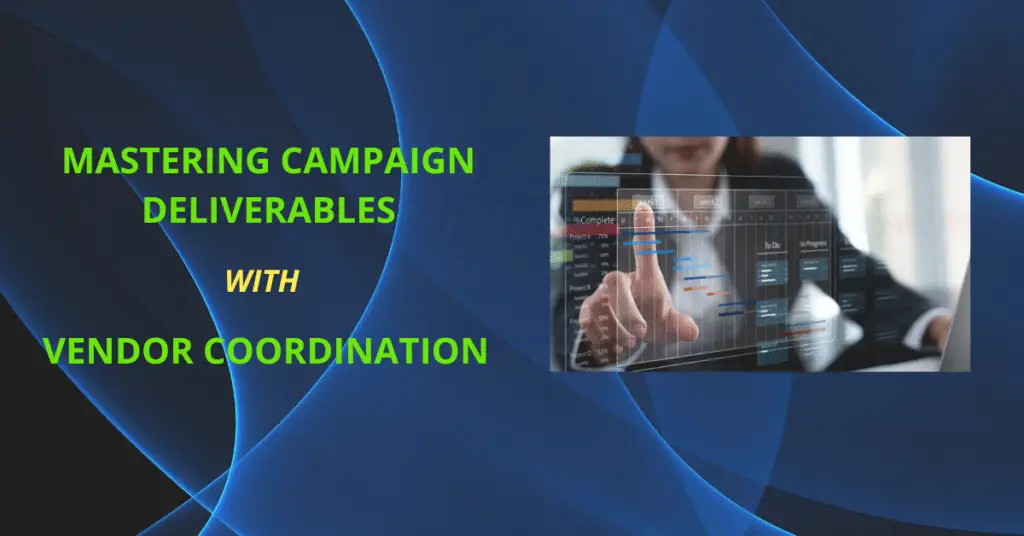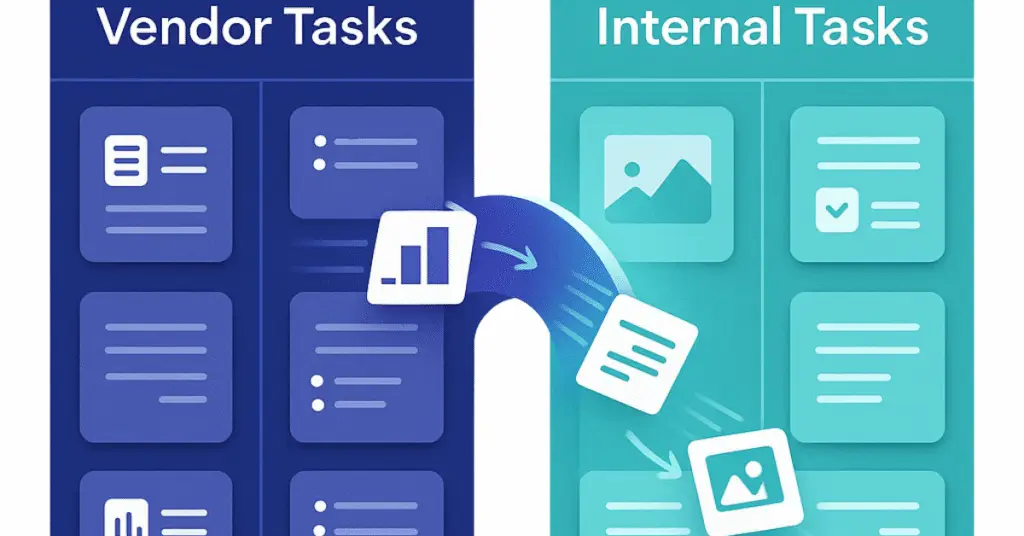
Mastering campaign deliverables requires precise vendor coordination and seamless B2B vendor collaboration. B2B marketing teams often rely on a network of specialized partners to execute complex campaign deliverables that demand agility, expertise, and scale. External vendors play a pivotal role by delivering services and assets that internal teams may lack the resources or skills to provide on their own. From content creation to marketing automation and analytics, vendors supply the building blocks that bring complex campaigns to life—and seamless vendor coordination ensures each piece lands exactly when and how it’s needed.
The Impact of Vendor Collaboration on Campaign Results
The successful integration of external vendors directly influences the outcome of campaign deliverables. Well‑orchestrated B2B vendor collaboration can mean the difference between meeting campaign objectives and falling short on quality, timelines, or compliance. When organizations effectively align vendor tasks with internal processes through robust campaign workflow integration, they not only increase operational efficiency but also support innovation and broader reach.
Common Challenges in Coordinating Campaign Deliverables
Every B2B team working with external vendors on campaign deliverables knows that obstacles are almost inevitable. While partnerships create opportunities for scalability and expertise, the coordination process is rarely seamless. Several recurring challenges can undermine the quality and timeliness of campaign outputs if left unaddressed:
Miscommunication and Mismatched Expectations
One core issue is miscommunication between internal stakeholders and vendors. Information may be incomplete, goals can remain ambiguous, or channels for feedback may not be established. This can create confusion about deliverable requirements and lead to teams working on different interpretations of the same brief. Clarity around approvals and feedback windows often suffers as a result, increasing frustration on both sides.
Timeline Delays and Missed Deadlines
Campaign schedules depend on multiple dependencies. When vendors lack visibility into shifting project priorities or when stakeholders do not provide timely input, delays accrue. The agile nature of modern marketing means deadlines often move, but unless all parties update their plans collaboratively, key assets may be late—or rushed at the expense of quality. Periodic status updates and shared project trackers help, but only if rigorously maintained.
Quality and Consistency Risks
Beyond delivery dates, quality assurance poses a significant risk. Vendors may use different standards or tools than the internal team, leading to inconsistencies across messaging, branding, or technical execution. Problems compound when multiple vendors contribute to a single campaign, raising the potential for incompatible file formats, off-brand visuals, or non-compliant messaging.
Fragmented Processes and Limited Oversight
Fragmented workflows make it hard to enforce accountability. If task tracking, communication, and asset management happen in silos, vital context slips through the cracks. For B2B marketing leaders, this adds pressure to implement integrated systems and standardized procedures. Solutions can bridge operational gaps, synchronize project flows, and support transparent vendor engagement from initial briefing to asset delivery.
Establishing Clear Objectives and Expectations
Aligning with external vendors relies on clarity from the start. Teams that invest time in setting transparent goals and deliverable standards see better overall results and less friction throughout campaigns. Without precise expectations, misunderstandings can lead to inconsistencies, missed deadlines, or outputs that fail to match a brand’s needs.
Defining What Success Looks Like
Every campaign should open with a discussion of what both sides expect. This goes beyond broad objectives; it means outlining the specific deliverables, timelines, and quality benchmarks. Effective vendor agreements cover:
- Clear descriptions of each deliverable—file types, formats, branding, and functional requirements
- Agreed timelines with review points or check-in milestones
- Success metrics that are measurable, not subjective (such as turnaround time, compliance rates, or engagement goals)
- Approval and revision workflows so all parties know what happens if requirements shift or deliverables need changes
Translating Objectives into Actionable Guidance
Templates, creative briefs, and checklists all help vendors understand how to meet expectations. Setting these up front reduces the likelihood of errors and rework, and gives teams a single reference point when questions arise. Open sharing of background information, brand guidelines, and campaign context also creates alignment from day one.
Early-stage consulting and documentation can be essential—especially for complex automation, data integration, or privacy-focused campaigns. This structure supports campaigns that not only launch on time, but also meet performance and quality metrics critical for B2B marketing success.
Building Strong Communication Channels
Miscommunication and fragmented workflows often undermine even the best vendor relationships. The solution lies in building strong communication channels that clarify progress, responsibilities, and expectations in real time. Direct conversation and structured processes help avoid small issues snowballing into missed deadlines or subpar deliverables.
Routine Check-Ins and Real-Time Updates
Short, regularly scheduled calls—whether weekly or aligned to project phases—allow both sides to review status, address blockers, and adjust priorities. These check-ins minimize ambiguity around task ownership and timing. For time-sensitive projects, real-time updates are critical. Shared dashboards or instant messaging platforms like Slack or Microsoft Teams facilitate transparent progress tracking. Tools with notification features help stakeholders respond quickly to time-sensitive questions.
Essential Collaborative Tools
- Project Management Platforms: Systems like Asana, Trello, and Jira provide a centralized space for timelines, deliverable tracking, and feedback. They eliminate confusion by providing a single source of truth for everyone.
- Document Sharing: Google Drive and Microsoft OneDrive streamline collaborative editing and asset approvals. Shared folders keep version control issues to a minimum and prevent miscommunications on asset status.
- Approval Workflows: Setting automated approval workflows within project management or content review tools ensures that nothing moves forward without the right visibility and sign-offs.
To keep campaigns accountable and aligned, establish clear communication protocols at the outset—define what gets escalated, how, and when. Assigning a single point of contact on both sides supports faster decisions and reduces bottlenecks.
Organizations seeking to optimize these processes often partner with B2B consultancies. They can help teams set up integrated communication systems, streamline collaboration, and automate alerts or approvals, supporting faster, higher-quality campaign deliverables from external vendors.
Integrating Vendor Workflows with Internal Processes
Clear objectives and expectations form the groundwork for effective vendor relationships. Yet, bridging the gap between external partners and internal teams requires something further: practical systems that bring disparate workflows into consistent alignment. Misaligned processes slow down campaigns, introduce inconsistencies, and increase compliance risks.

Keys to Successful Workflow Integration
The first step is mapping how vendors fit into current marketing operations. This means documenting how work passes between internal and external teams—covering briefing, production, feedback, review, and final delivery. Standardizing these hand-offs reduces ambiguity and error rates. Organizations often benefit from:
- Designating single points of contact for both internal and vendor teams to channel requests, updates, and queries
- Synchronizing project management tools, such as Asana or Jira, to ensure both sides see the same deadlines, responsibilities, and feedback threads
- Adopting shared folders or asset libraries for version control and consistent file organization
- Standardizing formats and templates for creative briefs, assets, and reports to minimize rework and friction
- Documenting clear escalation paths for issues that threaten compliance or campaign quality
Integrating Technology and Processes
Technology can close gaps between internal and external systems. Shared dashboards, for instance, give both parties visibility into status updates and review cycles. Automation helps transfer files or data, reducing manual mistakes. Integrations between marketing platforms and vendor systems—such as linking Eloqua or Marketo with creative production apps—ensure smooth data flow and version alignment.
Consultancies may help B2B teams audit and align workflows for each campaign stage. They introduce process automation, integration, and documentation tailored to the team’s tech stack and goals. This approach not only boosts consistency, but also prepares organizations for privacy audits and quality reviews. The result is fewer operational bottlenecks, and a higher certainty that vendors can deliver what’s required, when and how it’s needed.
Ensuring Data Security and Privacy Compliance
Coordinating with external vendors requires more than project management—organizations handling campaign deliverables must prioritize data security and privacy compliance at every engagement. B2B campaigns often exchange sensitive contact details, customer preferences, and performance analytics, all of which fall under tight regulatory expectations.
Understanding the Risks of Data Sharing
When vendors access or process marketing data, risks multiply. Shared files could contain personal information that is protected by regulations such as GDPR or COPPA. An unsecured file transfer, weak password, or unencrypted portal could expose confidential campaign data.
- Potential breaches: Unauthorized access, data leaks, or mishandled files
- Regulatory penalties: Fines and legal costs for non-compliance
- Reputational damage: Loss of trust from prospects, partners, or clients
Best Practices for Data Management and Privacy
To safeguard sensitive information, teams must blend strong vendor selection with documented privacy standards. Practical steps include:

- Limit access to data strictly to what vendors need for their tasks
- Use secure file-sharing tools—such as encrypted cloud storage or SFTP
- Require vendors to sign data processing agreements (DPAs) that outline privacy obligations
- Establish incident response protocols for reporting and mitigating any suspected breaches
- Train all stakeholders—internal and external—on compliance requirements relevant to every campaign
Leveraging compliance-focused solutions (like data anonymization and automated access controls), they ensure only pre-approved users can view or move sensitive assets. For B2B leaders, investing early in vendor onboarding and privacy tooling reduces operational risk while supporting transparent, legal, and reliable campaign execution. Learn more about privacy-first marketing best practices.
Leveraging 4TM Solutions for Seamless Vendor Collaboration
As campaign complexity increases, B2B teams need systems that bridge the gap between internal standards and external vendor capabilities. Technology and process consulting make the difference. 4Thought Marketing provides focused support for teams struggling with misaligned workflows, fragmented data, and uneven communication with outside agencies or service providers.
Optimizing Coordination Through Consulting and Tools
Consultants from 4Thought Marketing assess not just technology stacks, but also existing handoffs, approval processes, and data sharing practices. They help organizations:
- Map and document current vendor interaction points
- Identify workflow friction and inefficiency
- Design integrated project plans that sync internal marketing roles with vendor schedules
Many organizations rely on multiple marketing automation tools and CRM systems. 4Thought Marketing supports integration with platforms like Eloqua and Marketo, helping ensure that vendors interact with up-to-date campaign data and standardized templates. The result is a reduction in duplicated effort and manual error, while timelines stay visible to all contributors.
Streamlining Approvals and Reducing Compliance Risk
Approval delays slow down vendor deliverables. 4Thought Marketing helps clients automate approval flows and asset review cycles, using cloud-based tools to centralize decision-making and feedback. This shortens delivery times, improves transparency, and makes it easier to trace who approved what and when—crucial for both quality assurance and privacy compliance.
Strengthening Data Management and Privacy Controls
When vendors access sensitive data, compliance and security become major concerns. 4Thought Marketing implements privacy solutions, like 4Comply, that let B2B teams share only the information necessary for campaign execution. This approach helps organizations meet strict data handling requirements and adapt to privacy laws without creating operational drag.
Bringing in an experienced consulting partner helps B2B organizations maintain control and consistency, even as they scale their campaigns and vendor networks. This makes high-value external collaboration a strength, not a liability, for marketing operations teams focused on accurate, on-time campaign deliverables.
Conclusion: Evolving Vendor Partnerships for Sustained Marketing Growth
Vendor coordination is not a static process. B2B marketing teams that consistently deliver on campaign goals view vendor relationships as living partnerships rather than transactions. Campaign deliverables improve over time when organizations treat every vendor interaction as a chance to strengthen collaboration, optimize shared workflows, and refine best practices.
Continuous Improvement in Vendor Relationships
The most resilient B2B marketing functions make deliberate efforts to review processes, gather feedback, and adjust expectations with external vendors. This commitment ensures that quality, speed, and compliance keep pace with evolving organizational goals. Key actions for sustained growth include:
- Debriefing after major campaigns to identify bottlenecks or misalignments
- Inviting vendor input on how joint processes might be simplified or tasks automated
- Tracking quantitative metrics—such as turnaround times and error rates—to spotlight areas for improvement
- Staying proactive about changing privacy requirements or technology integrations that may require new vendor training or protocols
Consistent communication and a willingness to iterate make campaign deliverables more reliable and scalable. Strong partnerships move beyond basic compliance to focus on shared growth and mutual learning, which drives both innovation and long-term performance.
Strategic Use of Technology and Consulting
Sustaining these benefits often requires technical investment and operational discipline. Technologies that automate routine handoffs, safeguard sensitive campaign data, and standardize content or asset workflows minimize mistakes. Incorporating external expertise, such as from 4Thought Marketing, allows teams to benchmark against industry standards, accelerate integration, and deploy proven frameworks for managing vendor relationships. B2B organizations ready to evolve should treat vendor management as a core capability—updating processes regularly, training new team members thoroughly, and leveraging consulting support for complex integrations or campaign rollouts. By embedding continuous improvement into the fabric of vendor engagement, marketing teams ensure that external partnerships contribute not just to tactical execution, but also to sustained competitive advantage and growth.





